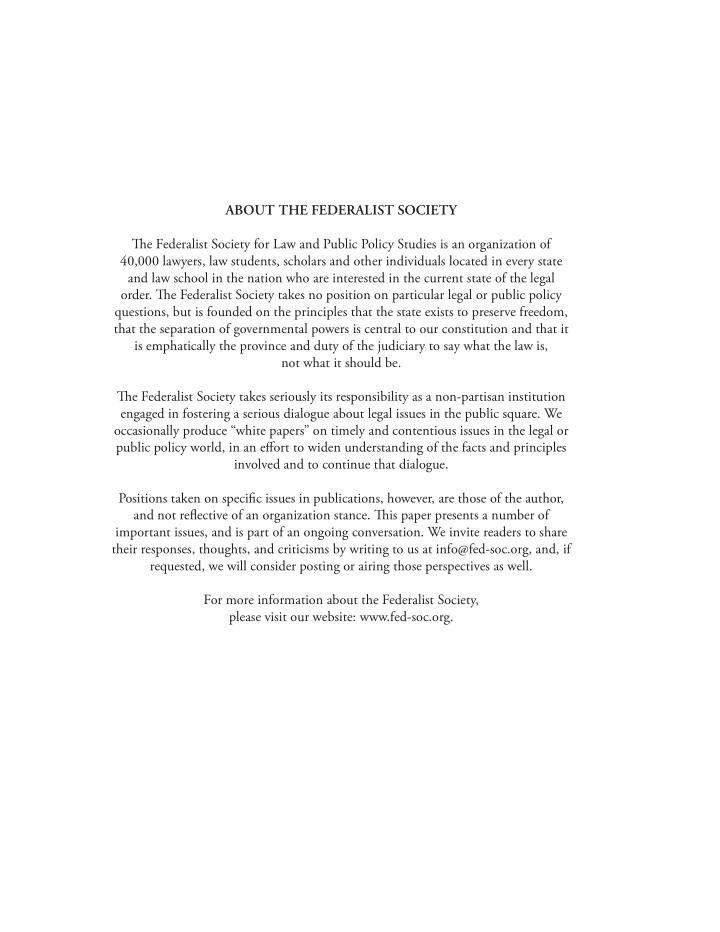



ABOUT THE FEDERALIST SOCIETY Ti e Federalist Society for Law and Public Policy Studies is an organization of 40,000 lawyers, law students, scholars and other individuals located in every state and law school in the nation who are interested in the current state of the legal order. Ti e Federalist Society takes no position on particular legal or public policy questions, but is founded on the principles that the state exists to preserve freedom, that the separation of governmental powers is central to our constitution and that it is emphatically the province and duty of the judiciary to say what the law is, not what it should be. Ti e Federalist Society takes seriously its responsibility as a non-partisan institution engaged in fostering a serious dialogue about legal issues in the public square. We occasionally produce “white papers” on timely and contentious issues in the legal or public policy world, in an eff ort to widen understanding of the facts and principles involved and to continue that dialogue. Positions taken on specifi c issues in publications, however, are those of the author, and not refl ective of an organization stance. Ti is paper presents a number of important issues, and is part of an ongoing conversation. We invite readers to share their responses, thoughts, and criticisms by writing to us at info@fed-soc.org, and, if requested, we will consider posting or airing those perspectives as well. For more information about the Federalist Society, please visit our website: www.fed-soc.org.
Dollars and Sense : Understanding the New Jersey Supreme Court’s Role in Education and Housing Frederic J. Giordano, Shauna Peterson & Robert T. Miller
decisions and consider whether they have raised costs Dollars and Sense: for individuals and businesses in New Jersey as some have argued. Some will say these decisions are consistent Understanding the New Jersey with the state’s constitution and, therefore, are the cost Supreme Court’s Role in Education of enforcing the law. Others will disagree and view the costs as a byproduct of judicial overreaching. Whatever and Housing the case, one thing is certain—courts play an enormous role in our lives and more debate about their role and Frederic J. Giordano, Shauna Peterson greater transparency respecting judicial selection ought & Robert T. Miller to be most welcome. Ti e New Jersey Supreme Court’s Structure and Membership T he State of New Jersey has experienced The New Jersey Supreme Court is comprised increasing economic diffi culties in recent years. of seven members—a chief justice and six associate Its state and local tax burden is the highest in justices. 11 Justices are nominated by the governor and the nation, totaling 11.8% of the average taxpayer’s must be approved by the senate. 12 Nominees must have income, 1 and the Tax Foundation ranked New Jersey’s been members of the New Jersey Bar for at least ten business tax climate as the most inhospitable in the years prior to their appointment. 13 Once confi rmed to nation in 2009. 2 Ti e state’s economic growth in terms the court, a justice holds offi ce for an initial term of of real GDP has stagnated. 3 seven years. At the end of this period, the governor may Deteriorating economic conditions in the state nominate the justice for reappointment, again with the may have caused New Jersey to begin losing two of its advice and consent of the senate. If reappointed, the most important assets: its businesses and its residents. 4 justice holds offi ce “during good behavior” and enjoys According to a Rutgers University study, between 2002 tenure until turning seventy, at which time the justice and 2006, the state lost 231,565 people. 5 Ti is decrease is by law required to retire. 14 in population resulted in a cumulative income loss of By tradition, the New Jersey Supreme Court is $7.9 billion between 2000 and 2005. 6 According to comprised of at least three justices from each major other surveys, only ten percent of New Jerseyans were political party. 15 However, this arrangement is neither satisfi ed with the way their state and local governments constitutionally nor legislatively mandated, and the operated in 2008, 7 and forty-nine percent of residents governor is free to disregard it in nominating individuals expressed a desire to leave the state in 2007. 8 Twenty- to fi ll vacancies. Ti e court currently consists of four eight percent of residents wishing to move cited high Democrats, two Republicans, and one Independent. property taxes as their most pressing concern. 9 Ti e court’s membership has changed signifi cantly Some have faulted high taxes and fees and excessive in recent years. Its longest serving member, Justice regulation for making it burdensome for businesses in Virginia Long, has been on the court for just more than New Jersey to grow and create new jobs. 10 While these ten years. 16 Two of the other members, Chief Justice are no doubt important factors, some say another may Stuart Rabner and Justice Helen Hoens, were appointed rest with various decisions of the New Jersey Supreme within the last three years. 17 Court aff ecting housing and education in the state. More important, the court’s composition will Ti e purpose of this white paper is to review these .......................................................................................... change signifi cantly in the near future. During the next governor’s term, at least one justice will reach mandatory Frederic J. Giordano is a partner in the Newark, New Jersey retirement age, and three others will become eligible for offi ce of K&L Gates LLP . Shauna Peterson is a student at the University of Chicago Law School (J.D. anticipated 2011). reappointment – one of whom, even if reappointed, Robert T. Miller is an Associate Professor of Law at the will reach mandatory retirement age during the same Villanova University School of Law. term. In particular, Justice Long will retire in 2012. 18 3
Recommend
More recommend